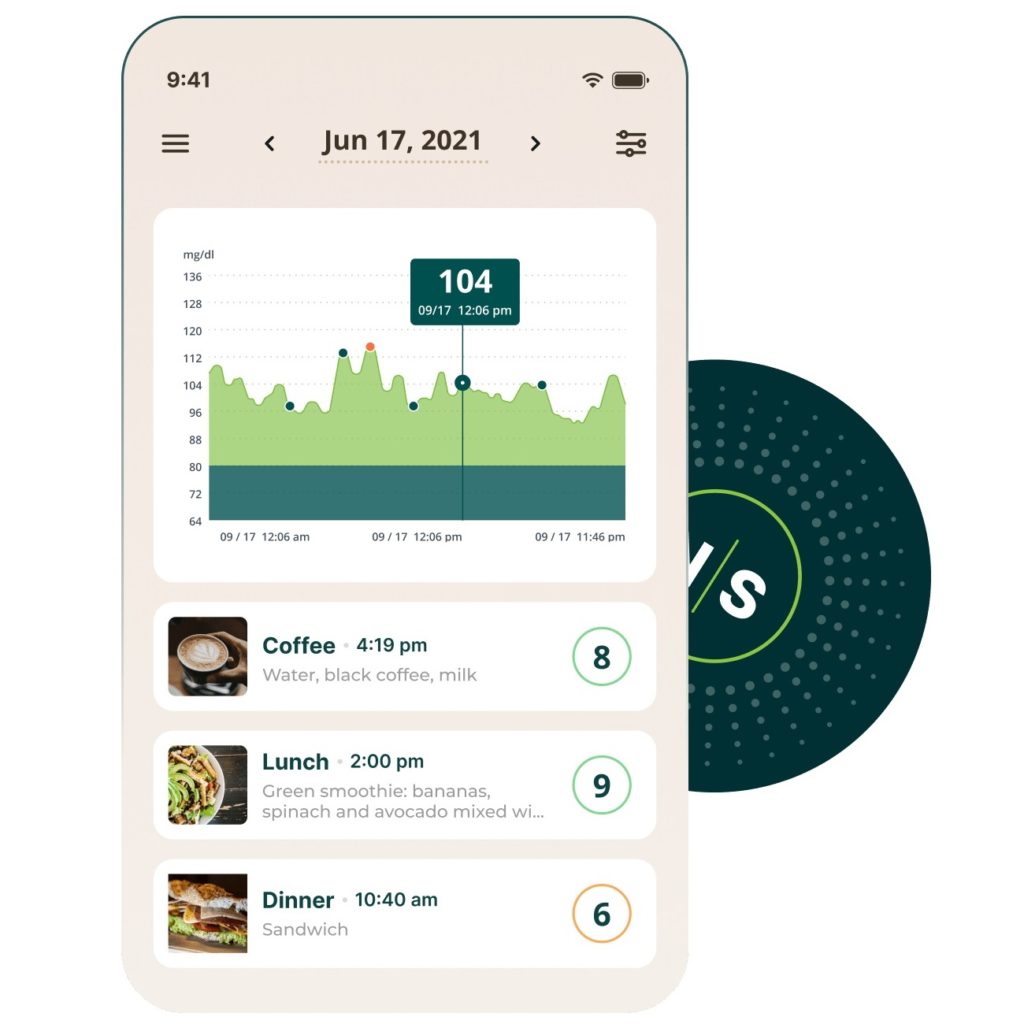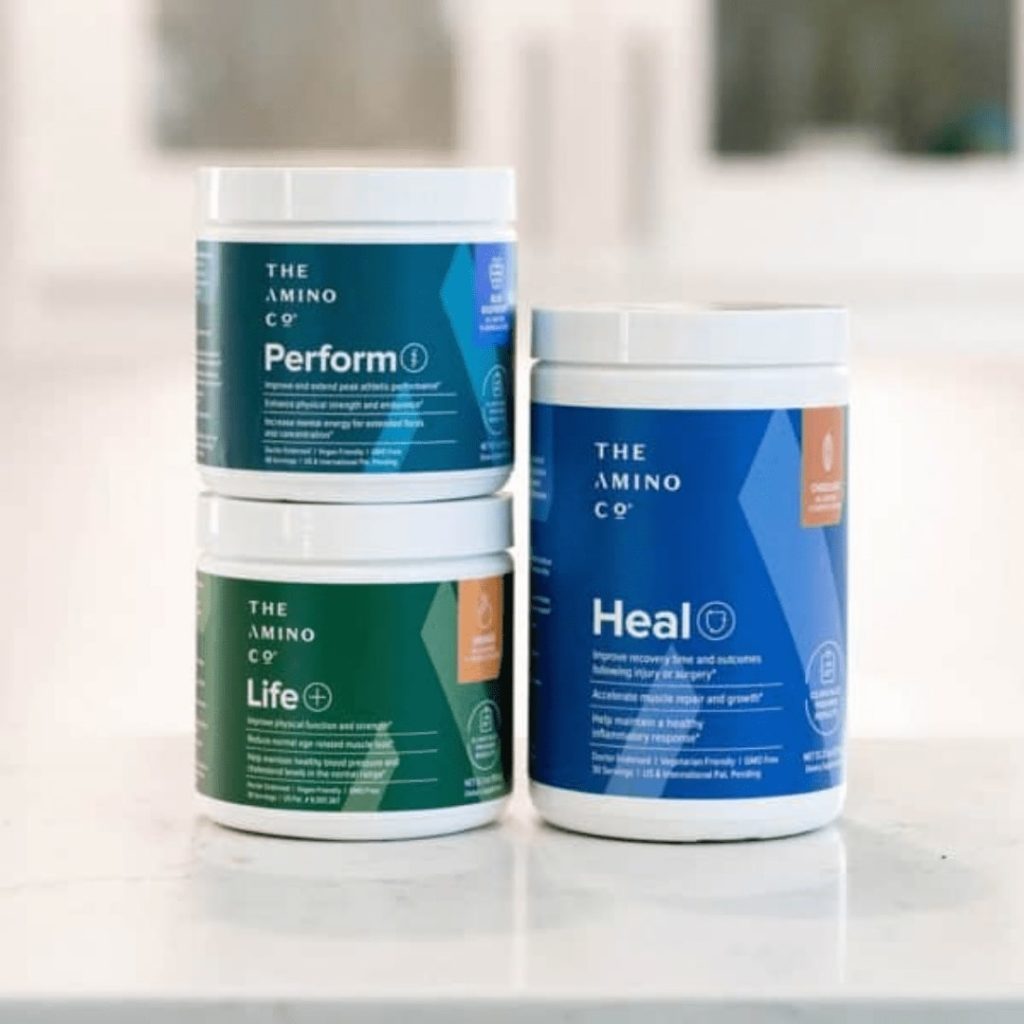NutriSense Review
In partnership with NutriSense
Table of Contents
About NutriSense
NutriSense provides users with personalized diet and lifestyle recommendations based on the results of data collected by a continuous glucose monitor (CGM). This subscription-based service sends you two CGMs monthly, as well as advice from a registered dietician or nutritional coach.
Keeping track of your blood sugar levels through the night and day, you’ll understand how certain foods, activities, or events trigger a rise. Perhaps more importantly, you’ll also learn what to do to keep these levels steady.
Blood carries important nutrients and cells around the body, delivering them where needed and taking away what’s not (carbon dioxide, waste, etc.). One of the things it carries is sugar. After you eat something sweet, that sugar is broken down and absorbed by your intestines where it then gets into your blood and is carried through your body.
Elevated blood sugar can cause inflammation and damage to your body. Continuously elevated levels may even hurt your organs, leading to disease. In the diet world, high blood sugar levels can mean a lack of focus, low energy, and even imbalanced hormones.
No matter which way you look at it, keeping your blood sugar levels steady is important to feel your best. That’s where NutriSense comes in. Developed in 2019 by Alex Skryl and Dan Zavorotny, the service helps you stay accountable and reveals how your habits affect your body.
This starts with the foods you eat but extends out to other habits like staying up late or skipping the gym. Everything you do plays a role in how your body operates, and with the brand’s CGM device, you’re able to see exactly what those roles are. Your personal data is delivered by way of an app, so you’ll have all of the stats at your fingertips.
Does this sound like the plan you’ve been looking for? This NutriSense review can help answer that question. I’ll get into the core of the brand and its programs, provide customers feedback, answer critical FAQs, and more, to help you in your final decision.
Recent Studies About Continuous Glucose Monitoring (CGM) Devices
Recent studies have highlighted the significance of continuous glucose monitoring (CGM) devices in diabetes management and their potential to improve overall health.
The 2019 review study discusses the transformative impact of continuous glucose monitoring (CGM) sensors on diabetes management. It highlights the real-time insights provided by CGM devices, which improve the safety and effectiveness of diabetes therapy. The review outlines the technological evolution of CGM devices, discusses their current use in diabetes care, and explores their beneficial impact in reducing hypoglycemia, glycemic variability, and improving insulin dosage tuning.
This 2015 study focuses on the variability of postprandial blood glucose levels and its association with prediabetes and type II diabetes. The researchers develop a machine-learning algorithm that incorporates various factors to predict personalized postprandial glycemic response to real-life meals. A dietary intervention based on these predictions results in lower postprandial responses and consistent alterations to gut microbiota configuration, suggesting the potential effectiveness of personalized diets in modifying elevated postprandial blood glucose levels.
This 2021 study investigates the postprandial glucose response (PPGR) to meals and its significance in managing diabetes mellitus (DM). The researchers propose a metric-learning approach using a Siamese neural network (SNN) to learn personalized PPGR embeddings. By analyzing the shape of the PPGR as measured by a continuous glucose monitor (CGM), the study aims to automatically identify the type of meal consumed. The findings show that the SNN-based embeddings outperform direct features, demonstrating potential for intelligent user interfaces to assist patients with DM in dietary monitoring.
In summary, these studies highlight the positive impact of CGM devices on diabetes management. They discuss the real-time insights provided by CGM, the potential of personalized diets in modifying postprandial blood glucose levels, and the use of machine learning and neural networks to improve meal classification and dietary monitoring for individuals with diabetes.
NutriSense Pros & Cons
Ready to find out more about what this program can do for you? It’s all coming up in this NutriSense review. We’ll take a look at the brand’s pros and cons first, then jump into its smart plans.
Pros
- Personalized Insights: NutriSense provides personalized insights into how your body responds to different foods, helping you understand the impact of your dietary choices on your blood glucose levels. This can empower you to make more informed decisions about your nutrition.
- Continuous Glucose Monitoring (CGM): NutriSense utilizes CGM technology, which allows for real-time monitoring of your glucose levels throughout the day. This continuous data can provide a more comprehensive picture of your glucose response, enabling you to identify trends and patterns.
- Coaching and Support: NutriSense often offers personalized coaching and support from registered dietitians or health coaches. They can help you interpret your glucose data, provide guidance on nutrition choices, and assist you in achieving your health goals.
- Improved Glycemic Control: By gaining insights into your glucose levels and their response to meals, NutriSense can help you optimize your glycemic control. This can be particularly beneficial for individuals with diabetes or those seeking to manage their blood sugar levels.
Cons
- Cost: NutriSense’s services and CGM devices may involve costs that are not covered by insurance. While the investment in personalized nutrition can be valuable, it’s important to consider the financial implications.
- Device Wearability: CGM devices used by NutriSense require wearing a sensor on your skin. Some individuals may find the continuous wear of the device uncomfortable or inconvenient.
- Learning Curve: Understanding and interpreting the glucose data provided by NutriSense may require a learning curve. It may take time to familiarize yourself with the patterns, trends, and recommendations based on the data.
- Individual Variability: While NutriSense aims to provide personalized insights, it’s important to remember that individual responses to food can still vary. Factors like genetics, medication, and other health conditions can influence glucose response, which may not always be captured solely through CGM data.
It’s important to consider both the pros and cons of NutriSense to determine if its services align with your specific needs, goals, and preferences. Consulting with a healthcare professional can also provide guidance on whether it’s suitable for you.
How Does NutriSense Work?
NutriSense utilizes continuous glucose monitoring (CGM) technology to provide users with real-time data on their blood glucose levels.
The scientific principle behind NutriSense’s approach lies in the understanding that glucose levels are closely linked to various aspects of health, including metabolism, nutrition, and overall well-being.
Here’s a brief overview of how NutriSense works scientifically:
- Continuous Glucose Monitoring (CGM): NutriSense provides users with a CGM device that is typically worn on the skin, usually on the upper arm. The CGM device measures interstitial glucose levels, which represent glucose levels in the fluid between cells. The device uses a small sensor inserted under the skin to monitor glucose levels continuously throughout the day and night.
- Real-Time Glucose Data: The CGM device continuously measures glucose levels and sends the data wirelessly to a mobile app or device, providing users with real-time information about their glucose levels throughout the day. This data includes insights into postprandial (after-meal) glucose responses, fasting glucose levels, and patterns of glucose fluctuations over time.
- Data Analysis and Insights: NutriSense employs advanced algorithms and data analysis techniques to interpret the collected glucose data. They analyze patterns, trends, and correlations in the glucose levels to provide users with personalized insights into how their body responds to different foods, exercise, sleep, stress, and other lifestyle factors.
- Personalized Recommendations: Based on the analysis of the glucose data, NutriSense provides personalized recommendations and guidance to users. These recommendations may include insights into optimal meal timing, macronutrient composition, food choices, exercise routines, and lifestyle modifications to help optimize metabolic health, manage weight, improve athletic performance, and make informed dietary decisions.
- Coaching and Support: NutriSense often provides personalized coaching and support from registered dietitians, nutritionists, or health coaches. These professionals can help users interpret their glucose data, understand the implications for their health goals, and guide them in making sustainable changes to their nutrition and lifestyle.
It’s important to note that the information provided by NutriSense is intended for educational and informational purposes and is not a substitute for medical advice.
Individuals with specific medical conditions, such as diabetes, should consult with their healthcare providers for personalized guidance and management of their blood glucose levels.
NutriSense Review
In this section of our NutriSense review, we’ll introduce you to the brand’s two programs. At this time, the brand is approved to accept HSA and FSA payments, but not health insurance, Medicare, or Medicaid.
The brand offers two intensive programs, both of which I’ll walk you through in the next section of this NutriSense review. The first relies on the use of a CGM to determine blood glucose levels daily, while the other is more about health coaching. Let’s break things down and look at each one individually.
NutriSense CGM Programs
When you sign up for NutriSense, you’ll be sent a continuous glucose monitor (CGM) to keep track of your blood sugar levels around the clock. You’ll get a report each day, and with that, guidance from a Registered Dietician about how to interpret your results and learn from them.
Your CGM will show your blood glucose levels when you eat, sleep, exercise, and stress out. Based on your results, you’ll get a personalized diet plan and start making changes and seeing results.
The CGM Program comes with advice from a dietician for one month. After that, if you choose to continue with them, you’ll pay an additional $50/month. While on this program, you can expect to learn a lot about what your body positively responds to and doesn’t, what foods to stay away from, which to eat more of, and what activities will bring you the best results.
How much is this thorough program? It varies depending on how long you commit. We’ll break the pricing down below.
- 1 Month: This is a month-to-month subscription and comes with 2x 14-day CGM Sensors and a month of support from a dietician for $350
- 3 Month: You’ll stay on the plan for a minimum of three months, then go month-to-month afterward. You’ll get one month’s worth of advice from a dietician, along with two CGM sensors per month for $250 (a $300 savings)
- 6 Month: Your plan will have a minimum commitment of 6 months, going month-to-month afterward. You’ll get two GMC sensors per month along with one month with a dietician for $225 (save $750)
- 12 Month: You’ll be on your plan for a minimum of 12 months, going month-to-month after. Enjoy one month with a dietician along with 2 CGM sensors monthly for $200 (a savings of $1,800+)
NutriSense Nutrition Coaching Program
Unlike the CGM Program, the Nutrition Coaching Program only requires you to wear a CGM for the first 14 days to collect data. Your nutrition coach will take the data the device collects and make recommendations based on the results.
Designed to completely change your lifestyle, you’ll learn how to eat, sleep, and move in a way that serves you. You’re not adjusting your life to fit what worked for someone else, NutriSense is about truly personalized recommendations.
You’ll get unlimited in-app communication with your nutrition coach via chat and receive in-depth diet advice on calorie consumption, macronutrient ratios, and foods types. The Nutrition Coaching Program is a 3-month plan that will look like this:
- Month 1: Learn about the fundamentals of glucose, go through your data and meal log with a nutrition coach, and set goals
- Month 2: See how your implemented changes affect your body
- Month 3: Work on long-term goals and how to get there using the guidance of your nutritional coach
After your first three months, your plan will go month-to-month. Join the program for $175/month.
Who Is NutriSense For?
NutriSense is about improving the health of your metabolism. It’s ideal for those who want to become healthier, learn about their body, and feed it correctly. The program is essential in discovering your “perfect diet,” one that’s totally unique to your needs instead of a general “blanket diet” that’s the same for everyone who hops on board.
Meant for adults only, the program involves using a CGM to monitor your blood sugar. You’ll need to be comfortable inserting and wearing the device 24/7.
Alternatives
If you’re looking for alternatives to NutriSense, here are a few options to consider:
- Levels: Levels is a company that offers personalized metabolic health programs with a focus on glucose monitoring and nutrition. They provide access to continuous glucose monitors (CGMs), personalized insights, and expert coaching to help you optimize your metabolic health and achieve your wellness goals.
- MySugr: MySugr is a mobile app designed for diabetes management. It allows you to track your blood glucose levels, log meals, monitor insulin doses, and access personalized insights. MySugr offers a comprehensive approach to diabetes care and can be a helpful tool for managing your glucose levels and overall health.
- Nutrino: Nutrino is a platform that combines nutrition science, artificial intelligence, and machine learning to provide personalized nutrition recommendations. They analyze various factors such as health goals, medical conditions, dietary preferences, and biometric data to offer tailored meal plans and insights to support your nutrition journey.
- GlucoseZone: GlucoseZone is an online exercise platform designed specifically for individuals with diabetes. It provides access to guided exercise programs tailored to your fitness level and glucose targets. The platform offers a combination of exercise, education, and support to help you manage your diabetes and improve your overall health.
- MyFitnessPal: MyFitnessPal is a popular app that focuses on tracking nutrition and physical activity. It allows you to log your meals, monitor your calorie intake, set goals, and track your progress. While it doesn’t provide continuous glucose monitoring, it can be a helpful tool for overall nutrition tracking and weight management.
When considering these alternatives, it’s important to evaluate the specific features, pricing, and compatibility with your health goals and preferences.
Consulting with a healthcare professional or a registered dietitian can also provide valuable insights and guidance in choosing the right alternative for your needs.
NutriSense Reviews: What Do Customers Think?
While out and about on the web, we found that there are a lot of really helpful, detailed NutriSense reviews out there. Ones that provide in-depth feedback about what the brand’s program is really like from those who have used it. That’s great for us and even better for you, as you’re about to read about three of them right here.
The first one we’ll take a look at is from Gregfly.com. Walking us through their blood sugar glucose charts and the feedback provided by the brand, the NutriSense review talked about the stats on one of the charts. Here’s what it said about what causes their blood sugar spikes:
“So does instant oatmeal, shown above, yikes, might be time to try old-fashioned steel cut oats or drop oatmeal altogether! But the full range of data shown above is the kind of data you get from a CGM or continuous glucose monitor that you don’t get from the occasional finger prick.”
What we like about this excerpt is the way it shows what you can learn from the NutriSense CGM device and why it’s important to dieting or just eating in general for your body type. Not everyone is going to respond to foods the same way, nor would they know what those foods do to their bodies without seeing the report.
A truly valuable tool to have while losing weight, it was cool to see an example of what the CGM can do for you while on the program and how it can steer you in the right direction. Especially when coupled with feedback and guidance from a dietician.
The next NutriSense review we’ll take a look at here is from a blog called Keto Karma. It mentioned the usefulness of the CGM device in the respect of testing out foods—even ones they considered “safe.” Here’s what they said:
“One of the things I was looking forward to the most was being able to test different foods, like diet soda, some “low carb” items, and keto desserts. Since food reacts differently in everyone’s body, I was really excited to find out what things did well in my body and what things I should avoid—even if it was technically “keto friendly”.”
This is another interesting point about the CGM device. Helping you perfect and streamline your diet, you’ll be able to base your food decisions on numbers and facts, not just what someone else tells you is ok.
Our last NutriSense review comes from Fitnessista. For this one, we included details about what hooking up the CGM is like as there’s always a little hesitation when it comes to needles or the concept of continuously wearing something on/in your arm. In regards to that, the review read:
“Turns out, attaching the CGM was NOTHING like I imagined it would be. It was painless and super easy.” As for the experience as a whole, it continued, “The RD support was invaluable. I loved having the ability to ask questions, and she did an excellent job teaching me how to see my patterns, assess my response, and ideal target ranges.”
Overall, it looks like NutriSense is an incredibly beneficial experience. Easy to use and understand, members find what they learn during the program critical in the ways they eat for the rest of their lives.
Is NutriSense Worth It?
One of the things we love about NutriSense is its varying program lengths. Even if you sign up for one month, you’re likely to get something out of the program, learning what your body likes and doesn’t, along with expert advice to steer your lifestyle in the right direction.
What you get from the NutriSense program you’ll keep with you for the rest of your life. So even though the cost of it is more than what you’d pay for your average diet plan, it’s nothing like your average diet plan either.
NutriSense Promotions & Discounts
This service offers an intensive, personalized experience with health coaches in your back pocket. The way it’s structured makes its price tag understandable, but still, during this NutriSense review, we couldn’t help but keep an eye out for ways the brand cuts customers a break.
What we noticed was its tiered pricing. If you plan to keep the program up for at least 3 months, you’ll save a minimum of $300. That’s pretty huge. Staying on the wagon for an entire year? Save $1,800. Even better—no NutriSense promo code required.
Along with rewards for commitment, those on the CGM Program will get 1 month of FREE access to a Registered Dietician. Those on the Nutrition Coaching Program get 1 FREE CGM. Healthcare worker? You’ll get $50 off the first month of any program.
Where to Buy NutriSense
The brand operates completely online. The only place you can sign up for its services is directly from NutriSense.io.
FAQ
Who owns NutriSense?
Alex Skryl is one of the owners and founders of NutriSense. He has a background in computer science and has worked with big businesses like Trunkclub and is no stranger to founding successful brands. His partner, Dan Zavorotny also owns a piece of the company.
Can I pause my NutriSense subscription?
Life happens, sometimes unexpectedly. That’s why NutriSense allows members to pause their subscription for a duration of ½ of their plan’s time. For example, if you have a 12-month subscription, you can pause your plan for up to 6 months. That time can happen all at once or in chunks of one month over the year.
If you ever find you need to pause your NutriSense subscription, make sure you send an email to [email protected] 72 hours (if not more) in advance of your next billing date. You’ll need to get in touch with a team member within the same time frame to unpause your subscription as well.
What is NutriSense’s Privacy Policy?
The whole NutriSense system depends on your personal information to get results. Whether that’s your blood sugar, personal details (age, height, weight, gender), or recommendations. Of course, a lot of those things are truly personal, and it’s important they’re protected.
When you use Nutrisystem, you’re agreeing to the collection, and sometimes, the sharing of certain information you provide the brand with. Here’s what the brand collects:
- Personal information: name, gender, phone number, credit cards, email, and mailing address, IP address, username, password
- Health information: height, weight blood pressure, blood glucose, pre-existing medical condition, food tracking, sleep activity
- User submissions: posts or reviews
NutriSense understands that a lot of this is touchy information, and it goes through strict measures to keep it safe and away from people or organizations with unauthorized access. None of your personal information will be shared unless you give the brand permission to do so, for example, in the case of sharing it with an outside nutritionist or doctor.
What is NutriSense’s Shipping Policy?
The brand only ships its CGM devices within the USA. All of its other services are delivered virtually via the NutriSense app.
What is NutriSense’s Return Policy?
NutriSense offers 1, 3, 6, and 12-month plans with fixed terms. From the time you purchase online, you’ll have 72 hours to cancel your plan, but after that, you’ll be charged as agreed upon at checkout. If you do wish to cancel your plan, you’ll need to do one of two things:
- Submit a request via the NutriSense help desk
- Email [email protected] with the word “cancellation” as the subject
NutriSense subscriptions are non-refundable once you’ve paid for them, and nothing they send out to you cannot be returned for resale by law. If you’ve signed up for a 12-month term and wish to downgrade to 3 or 6, send the brand an email and they may be able to alter it for you.
There may be an early cancellation fee as well as a difference in prices between the longer and shorter plan (ie. a 12-month plan is $199/month whereas a 3-month plan is $250/month). When your term is up, you can go ahead and cancel altogether, just be sure to notify the brand’s support team well in advance to avoid auto-renewing charges.
How to Contact NutriSense
If you need any information that wasn’t included in this NutriSense review, get in touch with the company via:
- Website contact form
Email: [email protected]
Looking for more reliable ways to shed a few pounds? Then check out these trusted brands below:




















Ask the community or leave a comment
WRITE A REVIEWCustomer Reviews
Leave a review